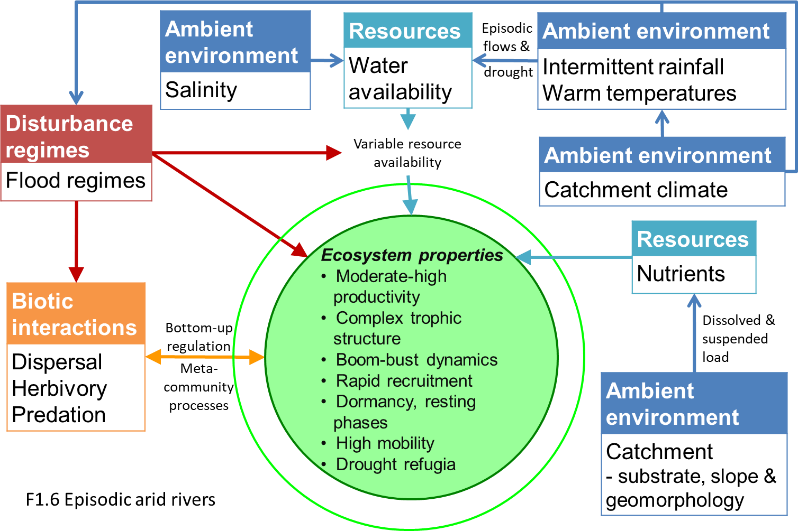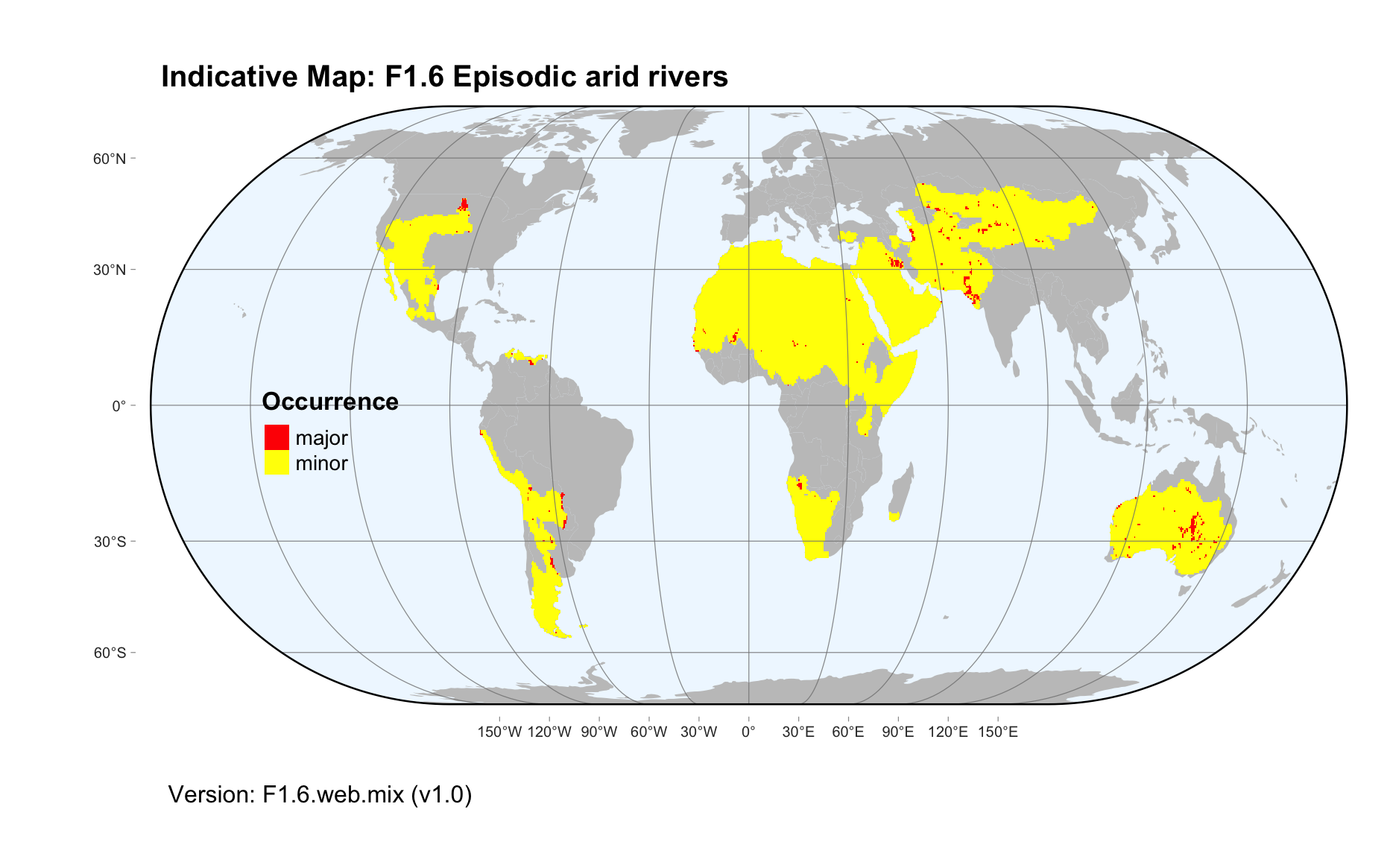Global ecosystem typology
Alternative site for the Global ecosystem typology with additional information for ecosystem profiles and indicative maps.
This site is maintained by jrfep
F1.6 Episodic arid rivers
Biome: F1. Rivers and streams biome
Contributors:
(texts)
These desert rivers occur mostly in flat areas of arid and semi-arid mid-latitudes. Channels are typically broad, flat, and often branching, with soft sandy sediments. They are dry most of the time, but punctuated by high-volume, short duration flows that transport nutrients and stimulate high productivity by algae and zooplankton. Plants and animals can either tolerate or avoid long, dry periods and then exploit short pulses of abundant resources, producing hotspots of biodiversity and ecological activity in arid landscapes.
Key Features
Rivers with high temporal flow variability which determines periods of high and low productivity, supporting high levels of biodiversity and complex trophic networks during floods and simple trophic networks during dry periods.
Overview of distribution
Arid and semi-arid landscapes in mid-latitudes mostly in lowlands.
Profile versions
- v1.0 (2020-01-20): JL Nel; RT Kingsford; RC Mac Nally; DA Keith
- v2.0 (2020-05-24): JL Nel; RT Kingsford; R Mac Nally; PS Giller; B Robson; AH Arthington; DA Keith
- v2.01 ():
- v2.1 (2022-04-06): JL Nel; RT Kingsford; R Mac Nally; PS Giller; B Robson; AH Arthington; DA Keith Full profile available at official site
Main references
Selected references for this functional group:
Kingsford RT (2006) Ecology of desert rivers Cambridge University Press, Cambridge. ISBN 13 978-0-521-81825-4
Sheldon et al. (2010) Ecological roles and threats to aquatic refuges in arid landscapes: dryland river waterholes Marine & Freshwater Research 61, 885-895
Diagrammatic assembly model

Maps
Maps are indicative of global distribution patterns are not intended to represent fine-scale patterns. The maps show areas of the world containing major (coloured red) or minor occurrences (coloured yellow) of each ecosystem functional group. See general notes on maps.
There are 2 alternative versions of the indicative map for this functional group, please compare description and sources below.
F1.6.IM.mix_v2.0
Datasets
- GSW-1.1
- FEOW-2008
- MERIT-Hydro
Map references
Pekel JF, Cottam A, Gorelick N, Belward AS (2016) High-resolution mapping of global surface water and its long-term changes Nature 540, 418-422 DOI:10.1038/nature20584
Abell R, Thieme ML, Revenga C, Bryer M, Kottelat M, Bogutskaya N, Coad B, Mandrak N, Contreras Balderas S, Bussing W, Stiassny MLJ, Skelton P, Allen GR, Unmack P, Naseka A, Ng R, Sindorf N, Robertson J, Armijo E, Higgins JV, Heibel TJ, Wikramanayake E, Olson D, López HL, Reis RE, Lundberg JG, Sabaj Pérez MH, Petry P (2008) Freshwater ecoregions of the world: A new map of biogeographic units for freshwater biodiversity conservation, BioScience 58: 403–414. DOI:10.1641/B580507
Yamazaki D., D. Ikeshima, J. Sosa, P.D. Bates, G.H. Allen, T.M. Pavelsky (2019) MERIT Hydro: A high-resolution global hydrography map based on latest topography datasets Water Resources Research vol.55, pp.5053-5073 DOI:10.1029/2019WR024873
F1.6.web.mix_v1.0

Datasets
- FEOW-2008
- GSW-1.1
Map references
Abell R, Thieme ML, Revenga C, Bryer M, Kottelat M, Bogutskaya N, Coad B, Mandrak N, Contreras Balderas S, Bussing W, Stiassny MLJ, Skelton P, Allen GR, Unmack P, Naseka A, Ng R, Sindorf N, Robertson J, Armijo E, Higgins JV, Heibel TJ, Wikramanayake E, Olson D, López HL, Reis RE, Lundberg JG, Sabaj Pérez MH, Petry P (2008) Freshwater ecoregions of the world: A new map of biogeographic units for freshwater biodiversity conservation, BioScience 58: 403–414. DOI:10.1641/B580507
Pekel JF, Cottam A, Gorelick N, Belward AS (2016) High-resolution mapping of global surface water and its long-term changes Nature 540, 418-422 DOI:10.1038/nature20584
Check: the Glossary / Profile structure / the public document